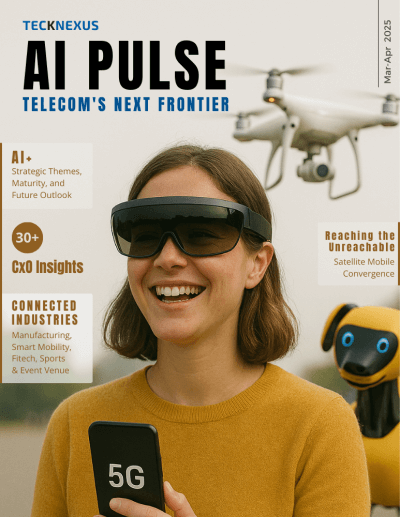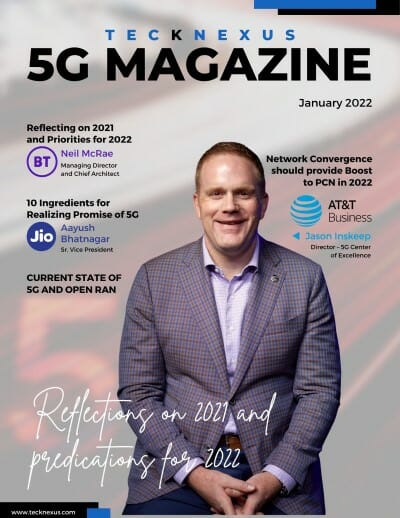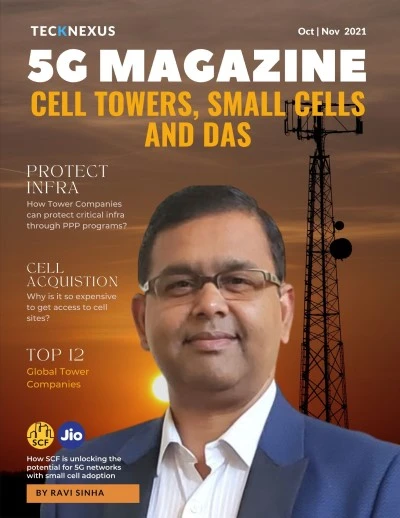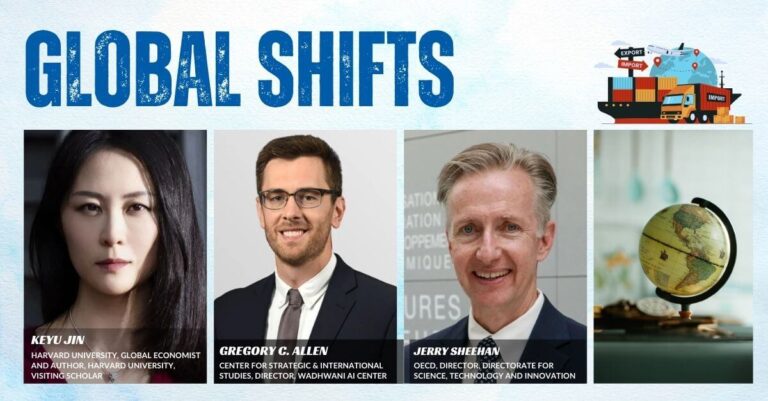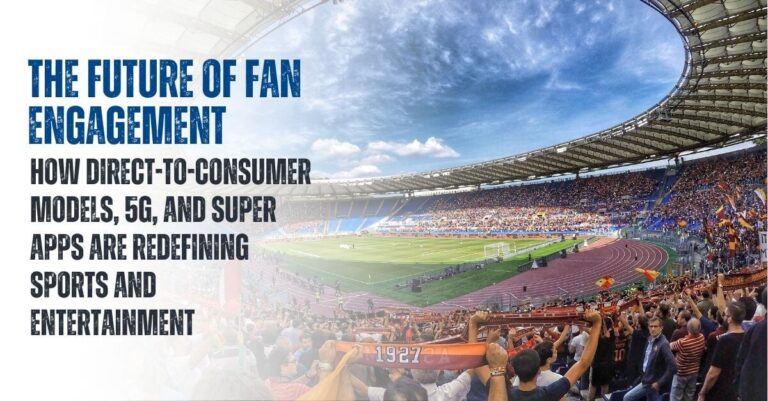Magazines and Articles
- All
- 2022 Predictions
- 2023 Predictions
- 5G and Beyond | 2024
- 5G Edge
- 5G for Manufacturing
- 5G for Transportation
- 5G Monetization
- 5G Towers
- AI Pulse for Telecom
- Featured
- Foundation
- Generative AI
- Leaders
- Open RAN | 2021
- Open RAN | 2022
- Perspective
- Private 5G/LTE and CBRS Networks | 2024
- Private Networks | 2021
- Private Networks | 2022
- Private Networks | 2023 Awards
- Satellites and NTN
- Security
- Tech and Connectivity
- TechFusion
- Telco Cloud
This article breaks down the core distinctions between Quasi-Earth fixed beams and Earth-moving beams in LEO/MEO satellite networks. It explores their application in both transparent and regenerative NTN architectures, the dynamic association of beams to ground cells, TAC list management, and the implications for UE mobility and network signaling.
In AI in Telecom: Strategic Themes, Maturity, and the Road Ahead, we explore how AI has shifted from buzzword to backbone for global telecom leaders. From AI-native networks and edge inferencing, to domain-specific LLMs and behavioral cybersecurity, this article maps out the strategic pillars, real-world use cases, and monetization models driving the AI-powered telecom era. Featuring CxO insights from Telefónica, KDDI, MTN, Telstra, and Orange, it captures the voice of a sector transforming infrastructure into intelligence.
In The Gateway to a New Future, top global telecom leaders—Marc Murtra (Telefónica), Vicki Brady (Telstra), Sunil Bharti Mittal (Airtel), Biao He (China Mobile), and Benedicte Schilbred Fasmer (Telenor)—share bold visions for reshaping the industry. From digital sovereignty and regulatory reform in Europe, to AI-powered smart cities in China and fintech platforms in Africa, these executives reveal how telecom is evolving into a driving force of global innovation, inclusion, and collaboration. The telco of tomorrow is not just a network—it’s a platform for economic and societal transformation.
In Beyond Connectivity: The Telco to Techco Transformation, leaders from e&, KDDI, and MTN reveal how telecoms are evolving into technology-first, platform-driven companies. These digital pioneers are integrating AI, 5G, cloud, smart infrastructure, and fintech to unlock massive value—from AI-powered smart cities in Japan, to inclusive fintech platforms in Africa, and cloud-first enterprise solutions in the Middle East. This piece explores how telcos are reshaping their role in the digital economy—building intelligent, scalable, and people-first tech ecosystems.
In Balancing Innovation and Regulation: Global Perspectives on Telecom Policy, top leaders including Jyotiraditya Scindia (India), Henna Virkkunen (European Commission), and Brendan Carr (U.S. FCC) explore how governments are aligning policy with innovation to future-proof their digital infrastructure. From India’s record-breaking 5G rollout and 6G ambitions, to Europe’s push for AI sovereignty and U.S. leadership in open-market connectivity, this piece outlines how nations can foster growth, security, and inclusion in a hyperconnected world.
In Driving Europe’s Digital Future, telecom leaders Margherita Della Valle (Vodafone), Christel Heydemann (Orange), and Tim Höttges (Deutsche Telekom) deliver a unified message: Europe must reform telecom regulation, invest in AI and infrastructure, and scale operations to remain globally competitive. From lagging 5G rollout to emerging AI-at-the-edge opportunities, they urge policymakers to embrace consolidation, cut red tape, and drive fair investment frameworks. Europe’s path to digital sovereignty hinges on bold leadership, collaborative policy, and future-ready infrastructure.
In The AI Frontier: Transformative Visions and Societal Impact, global AI leaders explore the next phase of artificial intelligence—from Ray Kurzweil’s prediction of AGI by 2029 and bio-integrated computing, to Alessandra Sala’s call for inclusive, ethical model design, and Vilas Dhar’s vision of AI as a tool for systemic human good. Martin Kon of Cohere urges businesses to go beyond the hype and ground AI in real enterprise value. Together, these voices chart a path for AI that centers values, equity, and impact—not just innovation.
In Technology Game Changers, leaders from Agility Robotics, Lenovo, Databricks, Mistral AI, and Maven Clinic showcase how AI and robotics are moving from novelty to necessity. From Peggy Johnson’s Digit transforming warehouse labor, to Lenovo’s hybrid AI ecosystem, Databricks’ frictionless AI UIs, Mistral’s sovereignty-focused open-source models, and Maven’s virtual women’s health platform, this article explores the intelligent, personalized, and responsible future of tech. The next frontier of innovation isn’t just smart—it’s human-centered.
Global Shifts explores how leaders like Keyu Jin and Gregory Allen are analyzing the breakdown of old globalization models and the rise of new strategic paradigms. Jin outlines the emergence of regional economic blocs, China’s shift toward technology self-reliance, and the decentralization of capital. Allen frames AI as a strategic battleground, discussing export controls, the rise of DeepSeek, and the risks of decoupling. The piece offers a critical look at how economic power and innovation are evolving in an era defined by urgency, sovereignty, and competition.
In Technology, Climate Change and Justice, top leaders from Arm, The B Team, Vattenfall, and Silo AI outline how technology can both fuel and fix the climate crisis. From Leah Seligmann’s values-driven climate leadership to Anna Borg’s clean-energy grids and Peter Sarlin’s push for efficient, open-source AI, this piece highlights how innovation must align with inclusion, sustainability, and resilience. The message is clear: solving climate change isn’t just about new tech—it’s about how we deploy it, who benefits, and whether it truly serves a livable future.
In Innovation In Action, executives from Time, Sierra, and Axios share how they’re redefining business, media, and journalism with AI. Time is unlocking over a century of content for fair AI use, while Sierra’s “agentic AI” elevates the customer experience across industries. Axios emphasizes human-first reporting with AI support. Across the board, these leaders show how strategic adaptation can embrace AI without compromising trust, transparency, or editorial integrity.
The future of manufacturing is intelligent, autonomous, and sustainable. Powered by private 5G networks, AI, and digital twins, smart factories are revolutionizing how goods are produced and maintained. From predictive maintenance to immersive virtual twins and AI-optimized energy systems, smart manufacturing is unlocking new levels of efficiency and innovation across industries—from ports and shipyards to agriculture and healthcare.
Smart mobility is reshaping how the world moves, powered by 5G, AI, and edge computing. From autonomous vehicles and real-time logistics to AI-driven drones and connected public transport, intelligent transportation systems are redefining urban mobility, logistics, and industrial automation. As global investment and collaboration grow, the transportation industry is transforming into a $11.1 trillion smart ecosystem focused on sustainability, efficiency, and connectivity.
FinTech, private 5G networks, and AI are converging to reshape digital finance across industries. From embedded payments and super apps to AI-driven credit scoring and secure M2M transactions, this $2 trillion opportunity is powered by mobile technology, cloud infrastructure, and regulatory evolution. Leaders must act fast to unlock new revenue, scale inclusion, and secure digital ecosystems.
The future of sports and entertainment is fan-first, immersive, and data-driven. Powered by D2C models, 5G networks, AI content creation, and super apps, industry leaders are reimagining fan experiences—from Bundesliga’s mobile strategy to Web2.5’s tokenized communities. The shift is not just technical but cultural, prioritizing personalization, monetization, and real-time interaction across every touchpoint.
Satellite-mobile convergence is rapidly shifting from niche to mainstream, enabling global mobile coverage through Non-Terrestrial Networks (NTN). With direct-to-device (D2D) standards now supported by 3GPP Releases 17–19, traditional mobile phones can connect directly to satellites. This development has unlocked use cases in emergency response, smart agriculture, logistics, and IoT—paving the way for a future where 6G, edge AI, and multi-orbit architectures redefine connectivity. Learn how telecoms, enterprises, and regulators are navigating the path to a fully connected planet.
The private network market is expanding rapidly as enterprises scale their private 5G/LTE deployments across industries like utilities, manufacturing, and oil & gas. Companies that began with single-site proofs of concept are now rolling out private networks on a larger scale, tackling challenges in security, IT integration, and SIM provisioning. Specialized vendors like OneLayer play a crucial role in streamlining deployment, enhancing security, and enabling seamless IT and OT ecosystem integration. Learn how private networks are evolving and the key factors driving adoption.
Learn about regenerative non-terrestrial networks (NTNs) and their role in advancing global connectivity. This article explores the differences between partial and fully regenerative architectures, key handover mechanisms, and the challenges and opportunities associated with satellite-based mobile connectivity.
Explore NTT DATA’s role in advancing private networks through enterprise 5G solutions, Edge AI, and Network-as-a-Service (NaaS). Learn how these technologies address digital transformation, operational efficiency, and security while offering businesses flexible, scalable, and reliable solutions tailored to their needs.
Discover how robust synchronization ensures 5G networks can handle critical use cases like emergency services and Industry 4.0. Learn about Precision TimeNet and ITU’s move to standardize network-based synchronization, reducing reliance on vulnerable GNSS systems and securing network resilience for a connected future.
TeckNexus is proud to announce the winners of the 2024 Private Networks Awards, celebrating outstanding achievements in private 5G, LTE, and CBRS innovations. This prestigious program honors companies, solutions, and collaborations that have transformed connectivity and redefined industry standards in sectors such as manufacturing, healthcare, smart cities, and public safety. The winners showcase how advanced private networks and strategic partnerships address complex challenges, drive innovation, and promote sustainable growth.
Award Category: Excellence in Private 5G/LTE Networks
Winner: Nokia
Nokia has been recognized with the TeckNexus 2024 Award for “Excellence in Private 5G/LTE Networks” for its transformative solutions that drive industrial digital transformation. Utilizing advanced technologies such as Nokia Digital Automation Cloud (DAC) and Modular Private Wireless (MPW), Nokia delivers secure, scalable, and high-performance connectivity tailored for Industry 4.0 applications. By addressing complex operational challenges through reliable, low-latency connectivity, AI-driven automation, and robust data security, Nokia empowers enterprises to optimize efficiency, enhance automation, and foster sustainability. With deployments across over 795+ enterprise customers and 1,500 mission-critical networks, Nokia’s innovative private wireless solutions are setting new standards for connectivity, operational excellence, and industrial growth worldwide.
Award Category: Excellence in Neutral Host Networks
Winner: Celona
Partners: Del Conca and T-Mobile
Celona’s innovative 5G LAN and Neutral Host solutions have been recognized with the TeckNexus 2024 Award for “Excellence in Neutral Host Networks” for transforming connectivity and operational efficiency at Del Conca USA, a leading manufacturer of fine Italian porcelain tiles. By addressing the limitations of legacy Wi-Fi systems, Celona deployed a robust, scalable private wireless network that significantly enhanced coverage, mobility, and operational resilience across Del Conca’s 30-acre facility. Leveraging the Citizen’s Broadband Radio Service (CBRS) spectrum, Celona’s solution delivered reliable, interference-resistant connectivity, optimizing real-time data communication for Automated Guided Vehicles (AGVs) and forklifts, thereby minimizing production delays and improving material handling efficiency. Additionally, Celona’s Neutral Host capabilities seamlessly integrated public cellular networks through a partnership with T-Mobile, providing uninterrupted indoor and outdoor connectivity for employees. This deployment not only showcased the transformative impact of Celona’s private 5G and Neutral Host solutions on manufacturing automation but also set a new benchmark for scalable, secure, and collaborative network integration across industrial environments.
Award Category: Excellence in Private Network Startups
Winner: GXC
GXC’s ONYX Platform, powered by Cellular Mesh technology, delivers scalable, seamless, and secure communication across industries. Recognized with the TeckNexus 2024 Award for “Excellence in Private Network Startups,” GXC’s proprietary Cellular Mesh technology and its ONYX Platform have established it as a frontrunner in delivering reliable, high-performance connectivity solutions tailored to meet the complex needs of enterprises.
Award Category: Excellence in Private Network Security
Winner: OneLayer
OneLayer’s innovative Zero Trust and Zero-Touch automation solutions provide unmatched security, visibility, and scalability for private LTE/5G networks. This approach has earned OneLayer the prestigious TeckNexus 2024 Award for “Excellence in Private Network Security,” recognizing their contributions to safeguarding private networks. By implementing robust security frameworks and automated device management, OneLayer empowers industries to efficiently manage and protect complex private cellular networks, enhancing network integrity and resilience through unmatched visibility, automated onboarding, and scalable security measures.
Award Category: Private Network Excellence in Generative AI Integration
Winner: Southern California Edison (SCE) & NVIDIA
Southern California Edison (SCE), in collaboration with NVIDIA, has been honored with the TeckNexus 2024 Award for “Excellence in Private Network AI and Generative AI Integration” for their transformative work in modernizing network operations through advanced AI and predictive analytics. Their initiative, Project Orca, exemplifies the power of AI-driven innovation, enhancing predictive capabilities, operational efficiency, and the reliability of critical infrastructure. This collaboration highlights how SCE and NVIDIA’s AI solutions redefine network operations, elevating performance and setting new standards for AI integration in private networks.
Award Category: Private Network Excellence in System Integration
Winner: L&T Technology Services (LTTS)
Partner: Ericsson, Athonet (HPE), Indian Mobile Operator
L&T Technology Services (LTTS) has been recognized with the prestigious TeckNexus 2024 Award for “Private Network Excellence in System Integration” for its advanced Private 5G integration solutions. This award highlights LTTS’s critical role in transforming industrial connectivity by enhancing operational technology (OT) and IT network reliability, boosting safety, and driving seamless automation across large-scale industrial environments. LTTS’s approach ensures optimal OT/IT convergence, increasing connectivity and operational efficiency and redefining standards for automation and network performance in the industrial sector.
Award Category: Private Network Excellence in Network Assurance
Winner: Anritsu
Partner: SmartViser, Major European Airline
Anritsu has been recognized with the TeckNexus 2024 Award for “Private Network Excellence in Network Assurance” for its outstanding achievements in ensuring private 5G/LTE network performance and reliability. This award highlights Anritsu’s comprehensive approach to network monitoring, business-centric KPIs, and performance analytics within mission-critical environments such as international airports. By leveraging advanced real-time monitoring, automated testing technologies, and collaborative solutions with SmartViser, Anritsu has set a new benchmark for maintaining optimal network efficiency, user satisfaction, and high-performance connectivity in complex private network scenarios.
Award Category: Private Network Excellence in Sustainability
Winner: Nokia
Nokia’s innovative Private Wireless Sustainability Calculator has been recognized with the 2024 TeckNexus “Private Network Excellence in Sustainability” award for its transformative impact on industrial, environmental and social sustainability. This first-of-its-kind tool enables industries to measure, optimize, and monetize their environmental and social impact as they transition from traditional Wi-Fi-only setups to advanced Industry 4.0 use cases powered by high-performance private wireless networks and mission-critical industrial edge solutions. By providing actionable insights to reduce energy consumption, optimize resource usage, and accelerate progress toward net-zero goals, Nokia’s solution exemplifies leadership in sustainable and energy-efficient private 5G/LTE network deployments, driving meaningful progress in industrial digital transformation and sustainability.
Award Category: Private Network Excellence in Innovation
Winner: Fiducia Sports AI
Fiducia Sports AI has been recognized with the TeckNexus 2024 Award for “Private Network Excellence in Innovation” for transforming fan engagement in the sports and entertainment industry. By leveraging artificial intelligence (AI), augmented reality (AR), and the power of public and private 5G networks, Fiducia’s innovative platform delivers real-time player stats, immersive AR experiences, and interactive content. This seamless and personalized connection enhances fan interaction with sports events across diverse platforms, redefining the fan experience and transforming how audiences engage with sports content, regardless of their location.
Award Category: Private Network Excellence in Manufacturing
Winner: Ericsson
Ericsson has been recognized with the TeckNexus 2024 Award for “Private Network Excellence in Manufacturing” for its transformative work at the USA 5G Smart Factory in Lewisville, Texas, and global deployments such as the Smart Factory Innovation Centre in Wolverhampton, UK, Atlas Copco Tools, and Toyota Material Handling’s facility in Columbus, Indiana. By integrating private 5G connectivity with advanced Industry 4.0 technologies, Ericsson has set new benchmarks for optimizing manufacturing processes, enhancing supply chain resilience, and elevating operational efficiency. This award underscores Ericsson’s leadership in leveraging private 5G to drive innovation in areas such as remote inspections, predictive maintenance, and sustainable production, redefining modern manufacturing standards through secure and scalable connectivity solutions.
Award Category: Private Network Excellence in Sports and Events Venue
Winner: NTT DATA
Partner: Cisco
NTT DATA, in partnership with Cisco, has transformed RAI Amsterdam into a smart, connected venue with the deployment of a private 5G network, earning the 2024 TeckNexus “Private Network Excellence in Sports and Events Venue” award. This smart venue innovation project optimizes visitor engagement, enhances operational efficiency, and supports RAI Amsterdam’s sustainability goals.
As a result, RAI Amsterdam has set a new benchmark for connected venues across Europe, delivering enriched visitor experiences, real-time analytics, and comprehensive event management capabilities.
Award Category: Private Network Excellence in Warehouse and Logistics
Winner: GXC
GXC’s deployment of its innovative Onyx LTE private cellular network at a large-scale poultry processing facility has earned the prestigious TeckNexus 2024 Award for “Private Network Excellence in Warehouse and Logistics.” This transformative project revolutionized connectivity and operational efficiency across the 50-acre facility, addressing critical challenges faced by the food processing industry. By enhancing data communication, inventory management, regulatory compliance, and operational processes, GXC demonstrated the powerful potential of private cellular technology to improve automation, tracking, and supply chain efficiency. The award-winning solution underscores how private networks can redefine warehouse and logistics management in the food processing sector and beyond.
Award Category: Private Network Excellence in Mining
Winner: Ericsson
Ericsson has been recognized with the TeckNexus 2024 Award for “Private Network Excellence in Mining” for its innovative application of private 5G technology to transform mining operations. This accolade highlights Ericsson’s leadership in modernizing the mining sector through high-speed, secure, and low-latency connectivity that drives safety, operational efficiency, and automation. By delivering private 5G solutions, Ericsson is redefining the mining landscape, enabling digitalization, enhancing remote operation capabilities, and promoting sustainable practices in one of the world’s most challenging industrial environments.
Award Category: Private Network Excellence in Airports
Winner: Ericsson
Partner: Purdue University & Saab
Ericsson, in collaboration with Purdue University and Saab, has been honored with the 2024 TeckNexus Award for “Private Network Excellence in Airports” for deploying a private 5G network at Purdue University Airport, transforming it into a “living laboratory” for aviation innovation. This initiative sets a new standard for airport operations by enhancing connectivity, enabling real-time data communication, and supporting advanced aviation applications such as autonomous systems, flight operations management, drone detection, and electric aircraft charging. By optimizing operational efficiency, safety, and sustainability, the private 5G network addresses complex challenges in the aviation industry. This deployment underscores Ericsson’s leadership in leveraging private 5G technology to modernize airport environments, paving the way for smarter, safer, and more sustainable air travel solutions globally.
Award Category: Private Network Excellence in Education
Winner: InfiniG
Partner: Parkside Elementary School, Intel, AT&T, and T-Mobile
InfiniG’s Mobile Coverage-as-a-Service (MCaaS) solution has earned the 2024 TeckNexus “Private Network Excellence in Education” award for its transformative impact on student safety and connectivity at Parkside Elementary in Murray, Utah. This innovative deployment, completed in partnership with Intel, AT&T, and T-Mobile, provided comprehensive in-building mobile coverage to address critical safety and communication challenges for students, teachers, staff, and parents. By enhancing secure and connected educational environments, InfiniG’s solution exemplifies the potential of private networks to improve campus security and foster more connected learning experiences.
Award Category: Public/Private Network Excellence in Healthcare
Winners: LifeSigns, floLIVE & Hetrogenous
LifeSigns, in partnership with floLIVE and Hetrogenous, has been recognized with the TeckNexus 2024 Award for “Private Network Excellence in Healthcare” for their LifeConnect 5G IoT-powered Connected Ambulance Solution. This transformative technology enhances emergency medical response by enabling seamless real-time patient monitoring, secure data transmission, and uninterrupted communication between ambulances and hospital teams. By elevating healthcare standards and improving critical patient care during emergencies, LifeConnect exemplifies the impactful use of connectivity to drive advancements in healthcare delivery.
Award Category: Private Network Excellence in Public Safety
Winner: Cumucore
Partner: Ripsim, Mosolabs, Starlink
When Hurricane Helene struck Western North Carolina, it left behind severe physical destruction and a critical communication crisis, isolating communities from essential resources and emergency services. In response, Cumucore, in collaboration with Ripsim, Mosolabs, and Starlink, deployed a resilient and scalable private mobile network that rapidly restored essential connectivity where it was needed most. This innovative deployment earned Cumucore the 2024 TeckNexus “Private Network Excellence in Public Safety” award, recognizing their transformative use of private network technology to enhance disaster response and ensure reliable communication for affected areas during emergencies.
Award Category: Private Network Excellence in Agriculture
Winner: Invences &
Partner: Trilogy Networks
Invences Inc., in collaboration with Trilogy Networks, has been recognized with the 2024 TeckNexus “Private Network Excellence in Agriculture” award for their pioneering deployment of a private 5G network tailored to transform farming operations. Implemented at a large-scale agricultural project in Fargo, North Dakota, this innovative collaboration drives digital transformation in agriculture through precision farming, real-time monitoring, AI-driven insights, and seamless data integration across rural and remote environments. Their efforts exemplify how 5G technology can revolutionize agricultural productivity and sustainability, setting new standards for efficiency and innovation in the sector.
Award Category: Private Network Excellence in Smart Cities
Winners: NTT DATA & Nokia
Partner: City of Brownsville
NTT DATA, in partnership with Nokia, has received the prestigious TeckNexus 2024 award for “Private Network Excellence in Smart Cities” for being selected to deploy a private 5G network in Brownsville, Texas. Thanks to these efforts, Brownsville is transforming from one of the least connected cities in the United States into a smart, connected hub pushing the boundaries of digital innovation.
Award Category: Private Network Excellence in Construction
Winners: Samsung & NAVER Cloud
Partner: Hoban Construction
Samsung and NAVER Cloud have been recognized with the 2024 TeckNexus “Private Network Excellence in Construction” award for their deployment of a private 5G network at Hoban Construction’s large-scale apartment project. This solution transformed construction site operations by addressing critical challenges in safety, efficiency, and communication. By enabling real-time monitoring, seamless integration of next-generation applications, and enhanced operational productivity, Samsung and NAVER Cloud’s private 5G network has set a new standard for optimizing construction processes, delivering advancements in site management and connectivity.
This article explores the deployment of 5G NR Transparent Non-Terrestrial Networks (NTNs), detailing the architecture’s advantages and challenges. It highlights how this “bent-pipe” NTN approach integrates ground-based gNodeB components with NGSO satellite constellations to expand global connectivity. Key challenges like moving beam management, interference mitigation, and latency are discussed, underscoring the potential and complexities in achieving seamless satellite-based mobile communication.
Cloud-based inventory management software is transforming how businesses handle their inventory, offering real-time tracking, cost savings, and enhanced collaboration. Unlike traditional systems, cloud-based solutions provide scalability, live data insights, and seamless integration, enabling businesses to efficiently manage orders, track stock, and optimize decision-making. With features like automated backups, powerful analytics, and 24/7 accessibility, companies can reduce costs and streamline operations.
Paul Warburton, Chief Digital and Marketing Officer NSC takes a look at the importance of prioritising the customer experience in the rapidly evolving landscape of technology, particularly with the advent of AI, 5G, and IoT. He warns that businesses risk stagnation if they focus solely on adopting cutting-edge technologies without aligning them with customer needs.
The convergence of AI, IoT, and 5G is transforming industries and creating new possibilities, but this progress must be balanced with considerations of privacy, sustainability, and accessibility.
AI projects are struggling to deliver expected benefits due to complexity, cost, time, technical challenges, and market dynamics. The innovation-adoption gap is outstripping the market’s ability to adapt and find practical applications, leading to overinvestment in promising ideas without sufficient market demand. A fundamental shift in perspective is needed: AI should be viewed as a tool to enhance human productivity, not as a replacement for humans. Successful AI projects incorporate humans at critical junctures, such as problem definition, data preparation, model training, output validation, and ethical oversight. Balancing potential with pragmatism is crucial for successful AI implementation.
Non-terrestrial networks (NTNs) have evolved from experimental satellite systems to integral components of global connectivity. The transition from geostationary satellites to low Earth orbit constellations has significantly enhanced mobile broadband services. With the adoption of 3GPP standards, NTNs now seamlessly integrate with terrestrial networks, providing expanded coverage and new opportunities, especially in underserved areas. This evolution is set to transform telecommunications by enabling innovative applications across various sectors.
Explore how Reliance Jio’s innovative platform, JioBrain, leverages generative AI to transform telecom operations. In this exclusive Q&A, Aayush Bhatnagar discusses JioBrain’s key features, 5G optimization, 6G readiness, and its impact on the Indian and global telecom sectors.
The article discusses the transformative impact of Generative AI on the telecom industry, highlighting its benefits in optimizing operational efficiency, enhancing customer support, and improving knowledge management. Generative AI streamlines processes, reduces the need for human intervention, and provides real-time, accurate responses. It is crucial in network performance, planning, and proactive maintenance, ensuring high reliability and service quality. The technology also facilitates personalized marketing and sales strategies, boosting customer engagement. However, the integration of Generative AI poses challenges such as data management, privacy concerns, infrastructure scalability, and the need for specialized expertise, which must be addressed to fully leverage its potential.


